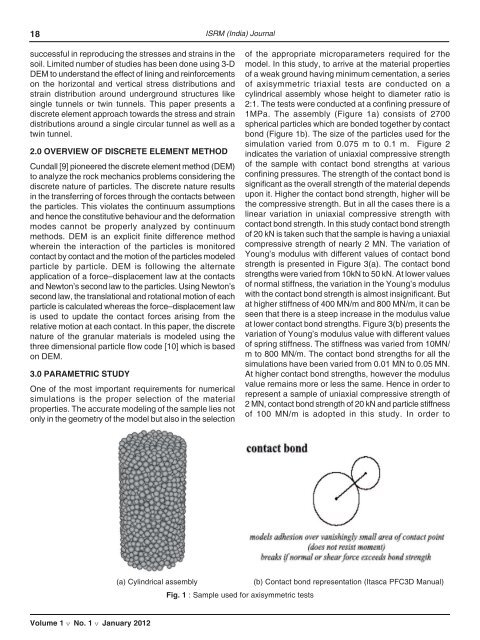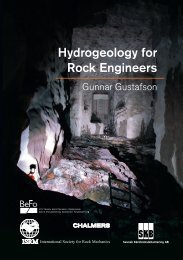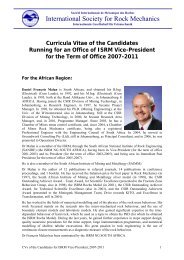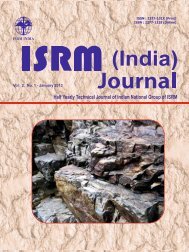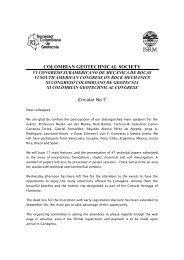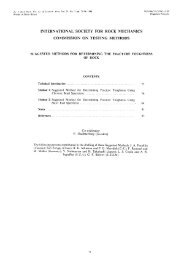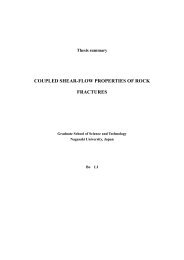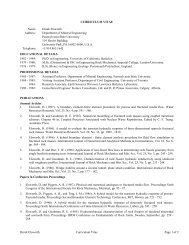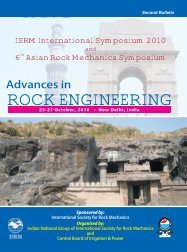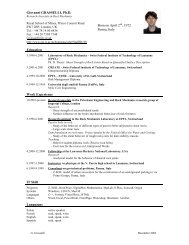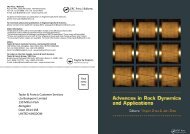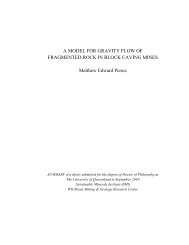ISSN - ISRM
ISSN - ISRM
ISSN - ISRM
You also want an ePaper? Increase the reach of your titles
YUMPU automatically turns print PDFs into web optimized ePapers that Google loves.
18 <strong>ISRM</strong> (India) Journalsuccessful in reproducing the stresses and strains in thesoil. Limited number of studies has been done using 3-DDEM to understand the effect of lining and reinforcementson the horizontal and vertical stress distributions andstrain distribution around underground structures likesingle tunnels or twin tunnels. This paper presents adiscrete element approach towards the stress and straindistributions around a single circular tunnel as well as atwin tunnel.2.0 OVERVIEW OF DISCRETE ELEMENT METHODCundall [9] pioneered the discrete element method (DEM)to analyze the rock mechanics problems considering thediscrete nature of particles. The discrete nature resultsin the transferring of forces through the contacts betweenthe particles. This violates the continuum assumptionsand hence the constitutive behaviour and the deformationmodes cannot be properly analyzed by continuummethods. DEM is an explicit finite difference methodwherein the interaction of the particles is monitoredcontact by contact and the motion of the particles modeledparticle by particle. DEM is following the alternateapplication of a force–displacement law at the contactsand Newton’s second law to the particles. Using Newton’ssecond law, the translational and rotational motion of eachparticle is calculated whereas the force–displacement lawis used to update the contact forces arising from therelative motion at each contact. In this paper, the discretenature of the granular materials is modeled using thethree dimensional particle flow code [10] which is basedon DEM.3.0 PARAMETRIC STUDYOne of the most important requirements for numericalsimulations is the proper selection of the materialproperties. The accurate modeling of the sample lies notonly in the geometry of the model but also in the selectionof the appropriate microparameters required for themodel. In this study, to arrive at the material propertiesof a weak ground having minimum cementation, a seriesof axisymmetric triaxial tests are conducted on acylindrical assembly whose height to diameter ratio is2:1. The tests were conducted at a confining pressure of1MPa. The assembly (Figure 1a) consists of 2700spherical particles which are bonded together by contactbond (Figure 1b). The size of the particles used for thesimulation varied from 0.075 m to 0.1 m. Figure 2indicates the variation of uniaxial compressive strengthof the sample with contact bond strengths at variousconfining pressures. The strength of the contact bond issignificant as the overall strength of the material dependsupon it. Higher the contact bond strength, higher will bethe compressive strength. But in all the cases there is alinear variation in uniaxial compressive strength withcontact bond strength. In this study contact bond strengthof 20 kN is taken such that the sample is having a uniaxialcompressive strength of nearly 2 MN. The variation ofYoung’s modulus with different values of contact bondstrength is presented in Figure 3(a). The contact bondstrengths were varied from 10kN to 50 kN. At lower valuesof normal stiffness, the variation in the Young’s moduluswith the contact bond strength is almost insignificant. Butat higher stiffness of 400 MN/m and 800 MN/m, it can beseen that there is a steep increase in the modulus valueat lower contact bond strengths. Figure 3(b) presents thevariation of Young’s modulus value with different valuesof spring stiffness. The stiffness was varied from 10MN/m to 800 MN/m. The contact bond strengths for all thesimulations have been varied from 0.01 MN to 0.05 MN.At higher contact bond strengths, however the modulusvalue remains more or less the same. Hence in order torepresent a sample of uniaxial compressive strength of2 MN, contact bond strength of 20 kN and particle stiffnessof 100 MN/m is adopted in this study. In order to(a) Cylindrical assembly (b) Contact bond representation (Itasca PFC3D Manual)Fig. 1 : Sample used for axisymmetric testsVolume 1 v No. 1 v January 2012


